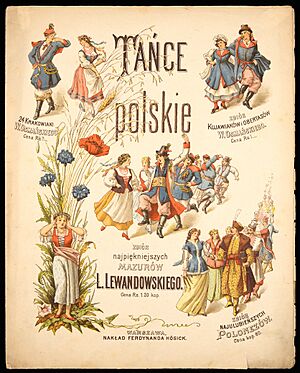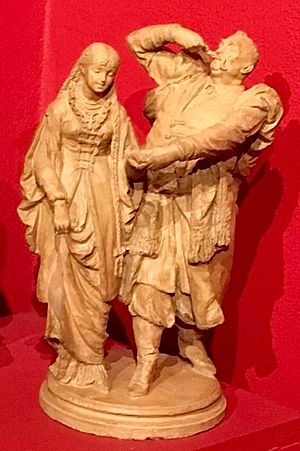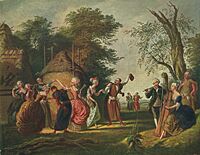Polonaise facts for kids

"Polish Dances. A collection of the most favorite polonaises", cover (1890)
|
|
| Native name | Polonez, chodzony |
|---|---|
| Genre | Traditional dance |
| Time signature | 3/4 |
| Origin | Poland |
| Polonaise, traditional Polish dance | |
|---|---|
|
UNESCO Intangible Cultural Heritage
|
|
| Country | Poland |
| Reference | 01982 |
| Region | Europe and North America |
| Inscription history | |
| Inscription | 2023 (18th session) |
| List | Representative |
The polonaise (pronounced poh-loh-NEZ) is a lively and elegant dance that comes from Poland. It's one of the five special national dances of Poland. This dance is usually performed in a 3/4 time signature, which means it has a steady, flowing rhythm. In Polish, its original name was chodzony, which means "walking dance," because it involves graceful walking steps. The polonaise became very popular and influenced many dances and musical styles across Europe.
The polonaise has a rhythm similar to the Swedish `polska` dance. These two dances actually share a common history! The `polska` dance was brought to Sweden a long time ago, during the time of the Vasa dynasty and the Polish–Swedish union.
Today, the polonaise is still very popular in Poland. It's often the first dance at big celebrations, like New Year's balls and national holidays. It's also always the opening dance at a studniówka, which is a special student ball in Poland. This ball happens about 100 days before important exams, like a senior prom in other countries. That's why it's called "studniówka," meaning "the ball of the hundred days."
In 2023, the polonaise was recognized by UNESCO Intangible Cultural Heritage Lists. It was added because it's seen as a way for people to celebrate together. It helps remember important family and community moments and shows ideas like teamwork, coming together, and fairness.
Contents
What Makes the Polonaise Special?
The polonaise is known for its unique rhythm. Imagine a steady, marching feel, but with a graceful, flowing movement. It's usually danced by couples who walk together in a grand procession. This makes it feel very formal and elegant.
A Dance with a Long History
The polonaise started as a simple peasant dance in Poland, possibly as early as the 15th century. Back then, it had different names like chodzony (pacer), chmielowy (hops), pieszy (walker), or wielki (great). Over time, it grew in popularity. It moved from the countryside to towns and then to the homes of nobles. By the late 1500s, even the lower Polish nobility were dancing folk versions of the polonaise, often with singing. It wasn't until the 17th century that it became widely known as the "polonaise." Eventually, it became a favorite dance of the Polish aristocratic class and developed into a more formal, instrumental dance.
Polonaise in Classical Music
The polonaise rhythm has inspired many famous composers. When you see "alla polacca" (which means "in the style of a polonaise") on a musical score, it tells musicians to play the piece with the special rhythm and character of the polonaise.
For example, the third part of Beethoven's Triple Concerto op. 56 is called "Rondo alla polacca." This shows how the polonaise rhythm was used in classical music.
Famous Composers and the Polonaise
Frédéric Chopin is probably the most famous composer known for his polonaises. His pieces are often grand and powerful. But many other composers wrote polonaises long before Chopin! For over 100 years, composers like Johann Sebastian Bach, George Frideric Handel, and Wolfgang Amadeus Mozart also wrote music inspired by this dance.
Other well-known composers who used the polonaise rhythm include Joseph Haydn, Ludwig van Beethoven, Franz Schubert, Carl Maria von Weber, Clara Schumann, Robert Schumann, Franz Liszt, and Pyotr Ilyich Tchaikovsky.
Even American composer Edward Alexander MacDowell wrote many polonaises. And John Philip Sousa, famous for his marches, composed the Presidential Polonaise. He wrote it in 1886 to help visitors move quickly through the White House during official events, after a suggestion from President Chester A. Arthur.
Tchaikovsky's opera Eugene Onegin also features a famous polonaise. It's a beautiful example of how this dance rhythm can be used in a dramatic story.
A National Treasure of Poland
The polonaise is more than just a dance; it's a symbol of Polish culture and history. It's one of the five official national dances of Poland. The other four are the Mazur (also known as Mazurka), Kujawiak, Krakowiak, and Oberek. Each of these dances tells a part of Poland's rich heritage.
Polonaise Around the World
The popularity of the polonaise spread far beyond Poland.
In France
In the 17th century, the polonaise arrived in French courts. It quickly became a popular dance across Europe. This elegant 3/4 meter dance was a favorite way to entertain the French royal court. The name "polonaise" became commonly used in France around the early 18th century.
In Saxony
Princess Anna Maria of Saxony loved polonaises so much that she collected over 350 pieces of sheet music for them throughout her life! She focused on finding the best examples of polonaise music.
In Maluku Islands
Even in the Maluku Islands (part of Indonesia), there's a dance called the polones. It's often danced at wedding receptions. This `polones` is a group dance that can look a bit like a country dance, a cèilidh (a traditional Irish or Scottish social gathering with music and dancing), or even a line dance. It shows how the polonaise's influence traveled across the globe!
Gallery
-
Polish Noblemen dancing Polonaise, painting by Jan Piotr Norblin
See also
 In Spanish: Polonesa para niños
In Spanish: Polonesa para niños





